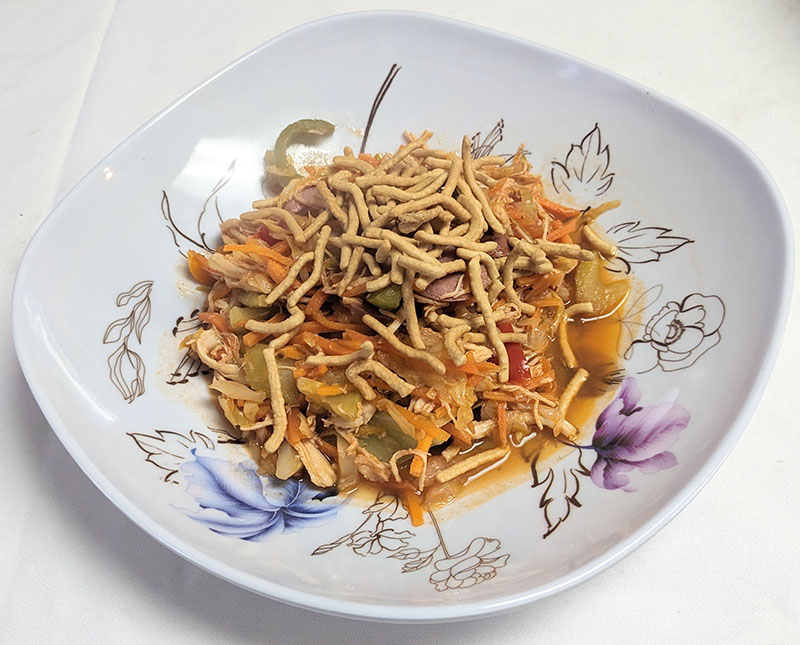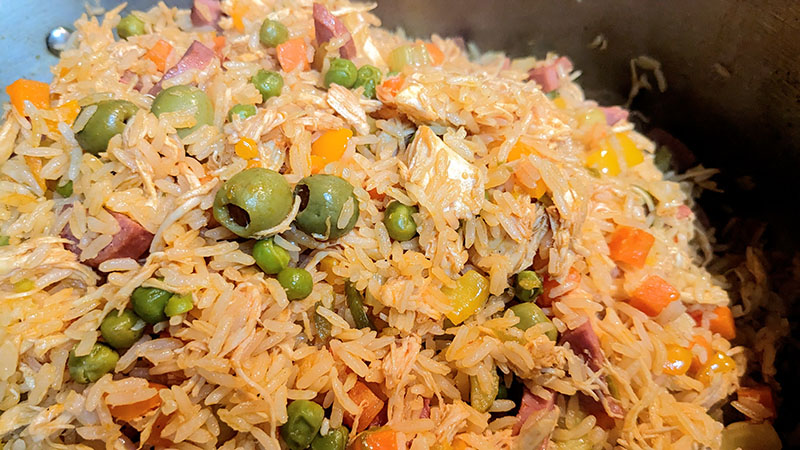Latino home-cooked meals are more diverse than meets the eye.
Inside a warm, yellow-toned home decorated with red lanterns, gold tassels, and a large Buddha, Marian Jimenez and her mother prepare for one of their favorite weekend rituals: cooking Nicaraguan dishes for six siblings, five grandchildren, friends, and extended family. On the menu this bright, sunny day: chop suey and arroz a la Valenciana.
Chop suey? Isn’t that Chinese? Well, yes, sort of. It’s Chinese-Latin American cuisine.
The largest migration of Chinese people to Latin America, primarily Cantonese from the Guangdong province, took place in the late 19th century, and there still are descendants of these migrants in the Americas to this day. It’s possible to trace where they settled by their impact on the local cuisine. For example, you can find chofan in the Dominican Republic (the local spelling for chow fun), chow mein in Mexico and Panama, and chop suey in many regions, including Costa Rica, Cuba, and Nicaragua.
Jimenez, 45, who is not Chinese but follows feng shui practices to bring good fortune, left the Nicaraguan capital of Managua nearly 30 years ago and came to Reno with her siblings and parents after brief stints in Miami, Fla. (where her mother worked in restaurants), and San Francisco, Calif. Her father’s work in automotive body shops brought them to Northern Nevada. Jimenez lives across the street from an in-law, and it’s here, near Sutro Street and Oddie Boulevard, where some Nicaraguans gather to enjoy food from home.
The women say that to make chop suey and arroz a la Valenciana (a rice and vegetable dish with chicken and sausage), they may spend a total of $80 to feed about 25 people. The veteran home cooks explained that for that price, they can feed guests and even have leftovers for their children and grandchildren to take home.
Chopping Away
“Chop suey has always been a dish we’ve made,” Jimenez says, dropping a stick of butter and cooking oil into a Dutch oven to start the cooking.
Her mother, Nelly Patiño, 67, assists with the vegetables, chicken and hot dogs, cabbage, and finally the wet ingredients, all of which go into this one-pot meal.

This process of making chop suey is easy, they say, in part because the cabbage, the main distinctive ingredient in chop suey, can be purchased shredded.
“This dish you can make during any season,” Jimenez says. “Now, because it’s so easy to prepare, it’s very popular for a last-minute event like a potluck or picnic.”
Due to the frequency with which the mother and daughter team prepare chop suey (and arroz a la Valenciana), they do not follow precise measurements for ingredients such as the Worcestershire sauce, garlic salt, and pepper.
“Todo a gusto,” Jimenez says. “Everything is done to taste.”
In other Latin American countries, chop suey may contain soy sauce, snap peas, cilantro, sherry vinegar, bean sprouts, and even beef. Costa Ricans, for example, in place of the Worcestershire sauce, use a homegrown sauce called salsa Lizano.
For the Nicaraguan version, the most important part is to add enough ketchup to give the chop suey color and flavor. Add some sugar or a small can of cola and mix well. That’s it.
Intra-national Cuisine
There’s a theoretical book written by a Mexican philosopher and politician of the early 20th century in which he labeled the future people of Latin America “the cosmic race.” The premise of his controversial thoughts is that because of the ethnic diversity of the population — Indigenous, Spanish, African, Asian, even Middle Eastern — the mixed-race coupling of these people will eventually constitute a new human race.
While this has not happened, what has is that the Chinese have also left a long-lasting mark, just like the Spaniards, West Africans, and Lebanese. As a result, what would be considered international foods are now part of Latin Americans’ intersecting identities.
Perhaps this is why Jimenez’s rice dish seems like a cross between a Spanish paella and Chinese fried rice.

Arroz a la Valenciana (Valencia likely being a reference to Spain and the famous paella dish that hails from it) actually doesn’t have any seafood in it, unlike its Iberian counterpart. Another departure from the original, Jimenez prepares the long-grain rice in advance instead of cooking it simultaneously with the other ingredients, as in paella.
Meanwhile, in a large sauté pan, Jimenez stir-fries frozen peas and carrots, chopped celery, and various peppers in a stick of hot butter and several teaspoons of cooking oil (any type). She adds pre-cooked, shredded chicken, hot dog slices, and Iberian green olives and continues to stir the ingredients.
The next most important ingredient, because it’s what gives the rice its scarlet color, is ketchup. For the quantity of rice, meats, and vegetables in this dish, Jimenez adds about half a bottle of the condiment. After some mixing, salt, mustard, minced garlic, onion, Worcestershire sauce, and chicken-flavored bouillon paste go in.
Stir well to ensure that the rice is fully covered in the reddish sauce. To complete the dish, add more green olives. Stir and serve.
Nicaraguan Chop Suey
(courtesy of Marian Jimenez, Sparks resident. Serves up to 25)
“It’s possible to enjoy this dish in every season because the ingredients are available year-round and they are affordable,” Jimenez says. “You can serve it with rice or bread.”
4, 14-ounce packages shredded cabbage
4 bone-in chicken breasts
1 package hot dogs
4 bell peppers (1 each of green, red, orange, and yellow)
3 stalks of celery
1, 10-ounce package shredded carrots
About ½ bottle ketchup
1 stick butter
2 tablespoons cooking oil
4 tablespoons Worcestershire sauce
Black pepper and garlic powder, to taste
7½ ounces cola or several tablespoons sugar
1 can of chow mein noodles (La Choy or similar)
Prepare by poaching several pounds of chicken breasts in broth, debone, and shred. Also, cook several hot dogs and cut them into bite-sized pieces. Julienne all peppers, and cut celery stalks into 1-inch portions.
In a Dutch oven or other large sauté pan, place a stick of butter and cooking oil. Add vegetables and allow them to sweat slowly over low heat for several minutes, long enough to soften up the veggies but not lose their structure. Next, add the meat. Stir the ingredients as they simmer for about 5 minutes to ensure flavors mix.
Add cabbage and stir, allowing the items to simmer down for several minutes, stirring throughout. This allows the natural liquids in the vegetables to cook the meal.
After the sliced cabbage is added to the Dutch oven and mixed, it’s important to let the items simmer again for about 5 minutes, stirring throughout. This allows the natural liquids in the veggies and the cabbage to cook the meal.
Add enough ketchup to give the chop suey color and flavor and, lastly, a can of cola (sugar can be used too, but cola is recommended for flavor). Stir, and serve warm. Garnish with chow mein noodles.
Arroz a la Valenciana
(courtesy of Marian Jimenez, Sparks resident. Serves up to 25)
2 pounds long-grain rice
4 bell peppers (1 each of green, red, orange, and yellow)
3 stalks of celery
Fresh or frozen peas and carrots (cubed)
1 cup onion, chopped
4 bone-in chicken breasts
1 package hot dogs
1 cup Spanish green olives with pimentos, plus more for garnish
2 cups ketchup
2 tablespoons mustard
1 stick butter
2 tablespoons cooking oil
4 tablespoons Worcestershire sauce
2 tablespoons chicken bouillon paste
2 tablespoons garlic, minced
2 teaspoons black pepper
2 teaspoons salt
Cook rice in advance and set aside. Poach several pounds of chicken breasts in broth, debone and shred. Also, cook several hot dogs and cut them into bite-sized pieces. Dice peppers, onion, and celery.
In a Dutch oven or other large sauté pan, add stick of butter and cooking oil. Add vegetables and allow them to sweat slowly over low heat for several minutes. Next, add meat and whole green olives. Stir ingredients while they simmer for about 5 minutes.
Next, add about 2 cups of ketchup, or about half a bottle, based on the quantity of rice, meats, and vegetables in this dish. Stir and mix so all elements become reddish in color. Lastly, add salt, mustard, minced garlic, Worcestershire sauce, and chicken bouillon. Mix well. Garnish with more green olives.


